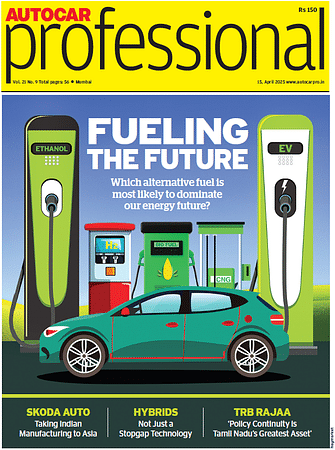‘Chance to be a global EV sourcing hub within our reach’
ACMA President Shradha Suri Marwah outlines the Indian auto-component industry's $7 billion investment plan, cost advantages and growing exports as India eyes leadership in EV component manufacturing.
The Indian automotive component industry has come a long way in the last decade since the advent of the government’s Make-in-India initiative aimed at driving local manufacturing of various technologies, including advanced automotive components. The auto component sector posted a turnover of Rs 6.14 lakh crore in FY24, registering 10% annual growth – boosted by a booming auto market. The next major target for the industry is exports. It wants to raise auto-component exports sharply to over $30 bn by FY26 from $21.2 bn in FY24, leveraging increased demand for cost-effective EV components from North America and Europe.
Shradha Suri Marwah, Chairperson, Subros, and President, Automotive Component Manufacturers Association of India (ACMA), reveals how the Indian components sector is poised to invest over US$ 7 billion (around Rs 58,000 crore) by FY28, to tap this opportunity and emerge as a global sourcing hub for EVs.
Could you review the Indian automotive component industry's performance in the last decade?
In the past decade, the Indian automotive component industry has truly come into its own, establishing itself as a key player on the global stage. With a consistent compound annual growth rate (CAGR) of 10.1%, we have seen a surge in vehicle production, a thriving aftermarket, and a significant boost in exports. This growth is reflected in our FY24 turnover of Rs 6.14 lakh crore (about US$ 74.1 billion), marking a robust 9.8% increase from the previous year. It is impressive to see how resilient and adaptable our sector has been in the face of various challenges, both globally and domestically.
The pandemic certainly posed significant hurdles, especially disrupting supply chains. However, the industry’s swift recovery after the pandemic showcases its strength. Emphasising localisation, innovation, and digitalisation has been essential in navigating these challenges and continuing our upward trajectory.
How has the industry evolved in terms of localisation and shaped itself as a robust resource for automotive OEMs in India?
The automotive component industry has made significant progress in its localisation efforts, evolving into a key resource for domestic OEMs. This shift is driven by the increasing demand for electric vehicles (EVs) and advanced automotive technologies, pushing the sector to invest heavily in localising critical components like electric motors, batteries, and automatic transmissions.
These investments align with India's broader ‘China-Plus-One’ strategy, aimed at diversifying supply chains and minimising risks associated with an over-reliance on imports from any single country, particularly China. Moreover, continued support from the government is yielding results, and the domestic market for components has grown significantly, with OEMs benefiting from reduced costs, quicker turnaround times, and more reliable local sourcing.
Industry collaborations and partnerships are also further advancing the localisation process, especially in bridging gaps in skills and technology. OEMs are increasingly collaborating with global manufacturers and technology providers to enhance local capabilities in advanced component manufacturing. These partnerships are crucial for ensuring that India not only meets its domestic needs but also competes effectively on the global stage.
How are component makers tapping into export opportunities? Where do you see industry exports going in the next 10 years?
Indian automotive component manufacturers are actively seizing export opportunities by investing in expanding their capacity and upgrading technologies. Currently, North America and Europe account for over 60% of India's auto component exports, driven by strong demand for advanced technology parts like electric motors and components for alternative fuel vehicles. As a result, Indian manufacturers are increasingly setting their sights on these markets, where there is a growing need for high-quality and cost-competitive components.
The ‘China-Plus-One’ strategy has opened new doors for Indian manufacturers to increase their share of the global market. Looking ahead, we project that exports could reach US$ 30 billion by FY26.
With ongoing investments aimed at localising advanced components, this upward trend seems promising. By FY28, the industry plans to invest Rs. 58,000 crore (around US$ 7 billion) to enhance its capability to supply advanced technology parts. Over the next decade, I am confident that Indian auto component manufacturers will further cement their position as a global sourcing hub, especially as the demand for electric vehicle components and sustainable technologies continues to grow.
What opportunities are component makers eyeing with EVs? Can India clinch the title of becoming a global sourcing hub for EV components in the future?
Component manufacturers are increasingly turning their attention to the EV market, which offers tremendous growth potential both in India and around the world. In fact, as per the Confederation of Indian Industries (CII), the Indian EV market is projected to reach nearly US$ 114 billion by 2029, fuelled by government policies that strongly promote electric mobility and a growing acceptance among consumers.
This transition opens tremendous opportunities for Indian auto component manufacturers to localise and ramp up the production of EV-specific parts like batteries, motors, and electronic systems. Initiatives like the Production-Linked Incentive (PLI) and FAME schemes are also crucial in this effort, providing financial support to strengthen domestic manufacturing and lessen our reliance on imports.
India's chance to emerge as a global sourcing hub for EV components is very much within reach.
Our competitive edge comes from cost-effective manufacturing, which is 10-25% cheaper than in Europe or Latin America, along with a strong local manufacturing ecosystem that meets international quality standards. Additionally, strategic partnerships with global firms are enhancing our technological capabilities.
Ongoing investments in infrastructure, including charging stations and battery manufacturing facilities, are also making the country an attractive option for EV production. With this positive momentum, I genuinely believe India is on track to become a global hub for EV components soon.
How is the China-Plus-One sentiment aiding business growth for component manufacturers based in India? What opportunities does it unlock for the industry?
As global companies seek to diversify their supply chains away from China, Indian component manufacturers are benefiting from increased export opportunities, particularly to North America and Europe, which together account for 63% of our exports. In FY24, India’s auto component exports grew by 5.5%, reaching $21.2 billion, and the China-Plus-One strategy has played a crucial role in this success. Indian companies are now in a strong position to expand their presence in global markets by capitalising on this shift.
Moreover, this strategy is drawing significant foreign investment into the Indian automotive sector. States like Tamil Nadu have successfully attracted over US$ 2.2 billion in investment proposals, establishing themselves as key hubs for both traditional and electric vehicle components. Overall, this approach is opening new opportunities for India to emerge as a global manufacturing hub, especially as the world increasingly shifts towards electric vehicles and sustainable mobility solutions.
What challenges does the industry foresee in the future as it undergoes a significant disruption?
The auto component sector is no stranger to disruptions. One of the biggest challenges we are facing right now is supply chain issues, including container shortages and rising transportation costs.
These logistics hurdles have been further complicated by bottlenecks in maritime transport, making it tough to ensure timely deliveries. Our reliance on international sourcing adds another layer of complexity, especially as global markets experience volatility.
Additionally, fluctuating commodity prices and market uncertainty make it challenging to plan for the future. This is why we need to invest in technological advancements, particularly as we transition to EVs and embrace innovations like advanced driver-assistance systems (ADAS).
However, this shift requires substantial financial investment and access to a skilled workforce that can manage these new technologies. Unfortunately, there is a shortage of skilled workers, which adds to the challenges we face. To stay competitive, our industry must tackle these obstacles head-on by focusing on innovation, making strategic investments, and developing our workforce.
What are ACMA’s recommendations to the government? What role are some of the existing schemes such as the PLI playing to define the Indian component industry's growth trajectory?
The auto component industry has put forth several recommendations to the government, aimed at enhancing domestic manufacturing and boosting our global competitiveness.
We believe it is essential to create a more favourable business environment, tackle tax concerns, and promote investments in advanced technologies. One key proposal is to reintroduce the additional investment allowance, which would incentivise capital expenditure (CapEx) and encourage companies to upgrade their production capabilities.
We also advocate for increasing depreciation rates on plant and machinery from 15% to 25%. This change would allow manufacturers to allocate more resources toward innovation and expansion, particularly for electric vehicle (EV) components. Furthermore, rationalizing GST rates on EVs and their components is crucial to making electric vehicles more accessible and affordable for consumers.
Regarding existing government initiatives, the PLI schemes have been pivotal in shaping the growth of the Indian automotive component industry. These schemes were launched to boost domestic manufacturing across various sectors and have proven particularly effective for us.
One of the most significant outcomes of the PLI schemes is the localisation of advanced automotive components. The automotive sector has identified 28 critical components for indigenisation, and we are already seeing positive results. Over the past two years, the industry has achieved a 5.8% reduction in imports, surpassing initial targets and showcasing the success of this initiative. This import substitution is vital, as we still heavily rely on imports for certain high-tech components, especially from China. The PLI schemes are helping us reduce this dependency by encouraging manufacturers to invest in domestic production and research and development.
Overall, government initiatives have played a crucial role in accelerating this transition. While it took some time for the PLI scheme to roll out, auto component manufacturers are now gradually starting to receive the incentives, which is helping us push further toward localization and innovation.
RELATED ARTICLES
Why Ather Chose to Go It Alone, Despite Hero’s Backing
The company could have plugged into Hero MotoCorp’s 6,000 dealerships, decades of manufacturing scale, and entrenched ve...
Earth Day 2025: Saving our planet by reducing emissions and applying 3R
Earth Day is every day, and anywhere you are. And in a time of rapid and adverse climate change, it’s the last call for ...
How Hyundai Is Building the Factory of the Future in India Using AI and ML
AI, ML, and robotics power manufacturing agility at Chennai and Talegaon.






 07 Oct 2024
07 Oct 2024
 2911 Views
2911 Views





 Ketan Thakkar
Ketan Thakkar




